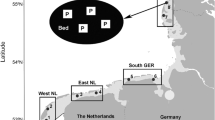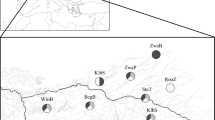Abstract
Spatially explicit models show that local interactions of hosts and parasites can strongly influence invasion and persistence of parasites and can create lasting spatial patchiness of parasite distributions. These predictions have been supported by experiments conducted in two-dimensional landscapes. Yet, three-dimensional systems, such as lakes, ponds, and oceans, have received comparatively little attention from epidemiologists. Freshwater zooplankton hosts often aggregate horizontally and vertically in lakes, potentially leading to local host–parasite interactions in one-, two-, or three-dimensions. To evaluate the potential spatial component of daphniid parasitism driven by these local interactions (patchiness), we surveyed vertical and horizontal heterogeneity of pelagic Daphnia infected with multiple microparasites in several north temperate lakes. These surveys uncovered little evidence for persistent vertical patchiness of parasitism, since the prevalence of two parasites showed little consistent trend with depth in four lakes (but more heterogeneity during day than at night). On a horizontal scale of tens of meters, we found little systematic evidence of strong aggregation and spatial patterning of daphniid hosts and parasites. Yet, we observed broad-scale, basin-wide patterns of parasite prevalence. These patterns suggest that nearshore offshore gradients, rather than local-scale interactions, could play a role in governing epidemiology of this open water host–parasite system.





Similar content being viewed by others
References
Alexander HM, Thrall PH, Antonovics J, Jarosz AM, Oudemans PV (1996) Population dynamics and genetics of plant disease: a case study of anther-smut disease of Silene alba caused by the fungus Ustilago violacea. Ecology 77:990–996
Anderson RM, May RM (1991) Infectious diseases of humans: dynamics and control. Oxford University Press, Oxford
Bolker BM, Pacala SW (1997) Using moment equations to understand stochastically driven spatial pattern formation in ecological systems. Theor Popul Biol 52:179–197
Bonabeau E, Toubiana L, Flahault A (1998) The geographical spread of influenza. Philos R Soc Lond B Biol 265:2421–2425
Brown DH, Bolker BM (2004) The effects of disease dispersal and host clustering on the epidemic threshold in plants. Bull Math Biol 66:341–371
Burdon JJ, Ericson L, Müller WJ (1995) Temporal and spatial changes in a metapopulation of the rust pathogen Triphragmium ulmariae and its host, Filipendula ulmaria. J Ecol 83:979–989
Burnham KP, Anderson DR (2002) Model selection and multimodel inference: a practical information-theoretic approach, 2nd edn. Springer, Berlin Heidelberg New York
Condreanu R, Condreanu-Balcescu D (1981) On two Metschnikowia yeast species producing hemocoelic infections in Daphnia magna and Artemia salina (Crustacea, Phyllopoda) from Romania. J Invert Path 37:22–27
Decaestecker E, De Meester L, Ebert D (2002) In deep trouble: habitat selection constrained by multiple enemies in zooplankton. Proc Natl Acad Sci USA 99:5481–5485
Duffy MA, Hall SR, Tessier AJ, Huebner M (2005) Selective predators and their parasitized prey: top-down control of epidemics. Limnol Oceanogr 50:412–420
Dixon PM (2001) The bootstrap and the jackknife: describing the precision of ecological indices. In: Scheiner SM, Gurevitch J (eds) Design and analysis of ecological experiments. Oxford University Press, New York, pp 267–288
Ebert D, Lipsitch M, Mangin KL (2000) The effect of parasites on host population density and extinction: experimental epidemiology with Daphnia and six microparasites. Am Nat 156:459–477
Ebert D, Hottinger JW, Pajunen VI (2001) Temporal and spatial dynamics of parasite richness in a Daphnia metapopulation. Ecology 82:3417–3434
Ericson L, Burdon JJ, and Müller WJ (1999) Spatial and temporal dynamics of epidemics of the rust fungus Uromyces valerianae on populations of its host Valeriana salina. J Ecol 87:649–658
Filipe JAN, Otten W, Gibson GJ, Gilligan CA (2004) Inferring the dynamics of a spatial epidemic from time-series data. Bull Math Biol 66:373–391
Folt CL, Schulze PC, Baumgartner K (1993) Characterizing a zooplankton neighborhood: small-scale patterns of association and abundance. Freshw Biol 30:289–300
Folt CL, Burns CW (1999) Biological drivers of zooplankton patchiness. Trends Ecol Evol 14:300–305
González MJ, Tessier AJ (1997) Habitat segregation and interactive effects of multiple predators on a prey assemblage. Freshw Biol 38:179–191
Green J (1974) Parasites and epibionts of Cladocera. Trans Zool Soc Lond 32:417–515
Grenfell BT, Bjørnstad ON, Kappey J (2001) Travelling waves and spatial hierarchies in measles epidemics. Nature 414:716–723
Hall DJ, Werner EE (1977) Seasonal distribution and abundance of fishes in the littoral zone of a Michigan lake. Trans Am Fish Soc 106:545–555
Hall SR, Duffy MA, Cáceres CE (2005) Selective predation and productivity jointly drive complex behavior in host–parasite systems. Am Nat 165:70–81
Holmes EE (1997) Basic epidemiological concepts in a spatial context. In: Tilman D, Kareiva P (eds) Spatial ecology. Princeton University Press, Princeton, pp 111–136
Ives AR (1991) Aggregation and coexistence in a carrion fly community. Ecol Monogr 61:75–94
Jakobsen PJ, Johnsen GH (1987) The influence of predation on horizontal distribution of zooplankton species. Freshw Biol 17:501–507
Keeling MJ, Rand DA, Morris AJ (1997) Correlation models for childhood diseases. Proc R Soc Lond B Biol Sci 264:1149–1156
Keeling MJ (1999) The effects of local spatial structure. Proc R Soc Lond B Biol Sci 266:859–869
Keeling MJ, Grenfell BT (2000) Individual-based perspectives on R 0. J Theor Biol 203:51–61
Keeling MJ, Woolhouse MEJ, Shaw DJ, Matthews L, Chase-Topping M, Haydon DT, Cornell SJ, Kappey J, Wilesmith J, Grenfell BT (2001) Dynamics of the 2001 UK foot and mouth epidemic: stochastic dispersal in a heterogeneous landscape. Science 294:813–817
Kratz TK, MacIntyre S, KE Webster (2005) Causes and consequences of spatial heterogeneity in lakes. In: Proceedings of the 10th Cary conference. (in press)
Lampert W (1989) The adaptive significance of diel vertical migration of zooplankton. Funct Ecol 3:21–27
Legendre P, Legendre L (1998) Numerical ecology, 2nd edn. Elsevier, New York
Lloyd M (1967) Mean crowding. J Anim Ecol 36:1–30
Mathworks, Inc (1999) Matlab 5.3: the language of technical computing. The MathWorks, Inc., Natick
Packer C, Holt RD, Hudson PJ, Lafferty KD, Dobson AP (2003) Keeping the herds healthy and alert: implications of predator control for infectious disease. Ecol Lett 6:797–802
Pinel-Alloul B, Downing JA, Pérusse M, Codin-Blumer G (1988) Spatial heterogeneity in freshwater zooplankton: variation with body size, depth, and scale. Ecology 69:1393–1400
Pinel-Alloul B (1995) Spatial heterogeneity as a multiscale characteristic of zooplankton community. Hydrobiologia 300–301:17–42
Real LA, McElhany P (1996) Spatial pattern and process in plant–pathogen interactions. Ecology 77:1011–1025
Stirnadel AH, Ebert D (1997) Prevalence, host specificity and impact on host fecundity of microparasites and epibionts in three sympatric Daphnia species. J Anim Ecol 66:212–222
Tessier AJ, Woodruff P (2002) Cryptic trophic cascade along a gradient of lake size. Ecology 83:1263–1270
Tilman D, Kareiva P (1997) Spatial ecology. Princeton University Press, Princeton
Acknowledgments
Our sincere thanks to P. Woodruff for her heroic efforts in helping us scan samples for infections. We thank T. Miller and two referees for their comments on a previous version of this manuscript. Primary funding for this study came from NSF grant OCE 02-35039 to CEC and OCE 02–35119 to AJT. MAD was supported by a NSF Graduate Research Fellowship. This is contribution #1170 from Kellogg Biological Station.
Author information
Authors and Affiliations
Corresponding author
Additional information
Communicated by Thomas Miller
Electronic supplementary material
Electronic supplementary material
Rights and permissions
About this article
Cite this article
Hall, S.R., Duffy, M.A., Tessier, A.J. et al. Spatial heterogeneity of daphniid parasitism within lakes. Oecologia 143, 635–644 (2005). https://doi.org/10.1007/s00442-005-0005-8
Received:
Accepted:
Published:
Issue Date:
DOI: https://doi.org/10.1007/s00442-005-0005-8




